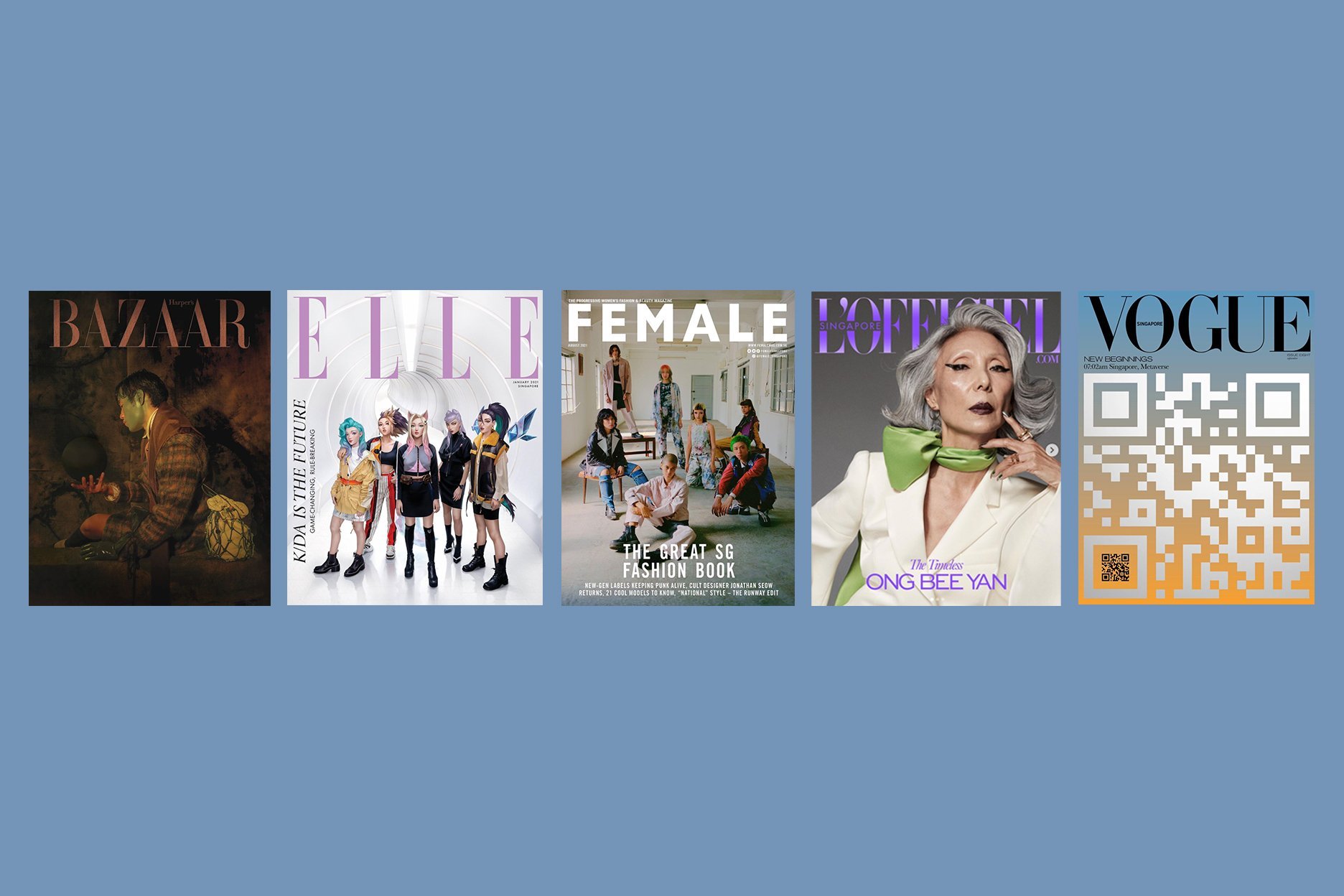My Own Words: Angelene Wong
Body and movement, fashion and dance
By Angelene Wong
Ever since my initiation into ballet during childhood, my creative life has been woven around performance and costumes. What started as a mere extracurricular pursuit developed into a freelance career as a professional dancer, choreographer, and instructor. Performing was not confined to the studio or stage but extended to bringing life to clothing in fashion campaigns for Singapore-based brands such as Love, Bonito, Yeomama Batik and Supertone, where, as a model, I brought my dancing repertoire in front of the camera. In this piece, I contemplate the poetic and methodological potential that dance unfurls in the space of fashion, wherein dance has intricately entangled itself with my fashion research, and how kinaesthesia illuminates novel pathways for the examination of fashion.
Behind the scenes, shooting for Vogue Singapore and National Arts Council’s “The Rhythm of Singapore” with dancers Sufri Juwahir and Maybelle Lek. Credits: Editor-in-chief @musingmutley; Creative producer @vanessa.caitlin; Photography @sayherheffernan; Film @requiem84 | @collabtive; Director of photography @badriladriel; Fashion director @monkiepoo, Stylist @joeyhysteric, Make-up and hair @themakeuproom_sg; Location: SkyPark Observation Deck @marinabaysands. Disclaimer: Social distancing rules were followed throughout these shoots.
At sunrise on July 14, 2021, I joined dancers Sufri Juwahir and Maybelle Lek on the Marina Bay Sands Skypark Observation Deck, soaring 57 floors above a still-awakening, overcast Singapore. Clad in H&M Studio's Autumn-Winter collection, we performed our choreographed sequence. Vogue Singapore's cameras captured the moment for a collaborative project with the National Arts Council titled "The Rhythm of Singapore," aligned with the magazine’s September issue. Inspired by our shared experiences of forging connections amidst Covid-19's social distancing and virtual confines, our movement embodied a camaraderie, breathing in unison and navigating the negative spaces around one another's bodies. Behind us, an expansive landscape depicted a pandemic-stricken Singapore, while the Vogue team, eager for the perfect shot, stood before us. This harmonious convergence of dance and fashion magnified the potency of movement within the fashion realm, albeit conveyed through screens, during a period devoid of live fashion shows.
Film still from “Plié: A Movement Meditation on Clothing as Protection, Ritual, and Performance,” videography by Isabelle Monteiro.
When I pursued my Master's in Fashion Studies at The New School, Parsons Paris, I explored the connection between my background as a dancer and my academic research. The exhibition — and accompanying book — titled Dance & Fashion, curated by Dr Valerie Steele at The Museum at the Fashion Institute of Technology, and Caroline Evans’ The Mechanical Smile greatly influenced my understanding of the intertwined histories of fashion, dance, and embodied cultural sensibilities. This experience led me to delve deeper into the collaborations between fashion and dance practitioners for my Master's thesis. I discovered that the ability of fashion and dance to impact or comment on each other, with the body as a central element, raised important questions.
The body posed methodological questions for fashion research. With Dr Joanne Entwistle’s key concept of dress as “situated bodily practice,” there emerged the problem that traditional research methods often struggled to capture the subjective nature of bodily experiences. Expressing these experiences through words — the traditional mode of academic communication — presented complex challenges. Curator Olivier Saillard's work became influential in this context. Although not specifically focused on dance, Saillard used performances to reflect on the fashion industry. For instance, in "Models Never Talk" (2014), iconic 1980s models shared their past experiences through spoken descriptions and bodily performances, highlighting the significance of their contributions to fashion history. Saillard's unconventional museological approach sought to document the ephemeral practice of modelling, capturing the models' "movement and memory." Thus, he elevated their experiences to a status worthy of preservation in the archive.
Film still from “Plié: A Movement Meditation on Clothing as Protection, Ritual, and Performance,” videography by Isabelle Monteiro.
A performative methodology emerged as a means to interpret, experience, and critique fashion phenomena. In 2022, curator Weiqi Yap invited me to participate in an exhibition at Fashion On Display through a creative interpretation of Lilia Yip's collection, "The Soul of Things." Embracing the garments' construction, shape, colour, and movement, along with Lilia's music, I allowed them to guide my choreographic process. Drawing inspiration from choreographer Damien Jalet's collaboration with fashion innovator Hussein Chalayan, where the costumes led the choreography, I selected three sets of garments and complementary sites before choreographing the piece. The first scene involved dancing with mannequins in Weiqi's studio, symbolising 'other bodies.' The second scene took me across different locations in Singapore's cityscape, playing with a dress and coat set, where I manipulated the coat to reveal hidden artwork. The third scene was filmed at an abandoned temple gate. These culminated in a dance film titled "Plié: A Movement Meditation on Clothing as Protection, Ritual, and Magic," referencing what each section explored. The title "Plié" draws on the etymological connection with "ploier," meaning to fold, pleat, or layer, capturing how cloth envelops the body's movements, each new motion imprinting a new wrinkle. The fabric serves as a palimpsest, embodying the past and present, while the dance perpetually rewrites its narrative.
Film still from “Plié: A Movement Meditation on Clothing as Protection, Ritual, and Performance,” videography by Isabelle Monteiro.
“Plié” prompted me to think about fashion through movement. Presently, I am writing my doctoral thesis on late 20th-century fashion modelling practices in Singapore. As part of my research, I am experimenting with somatic practices to interpret poses, recognising the significance of the body in fashion, particularly in the context of female and postcolonial bodies. Insights from decolonial, feminist, and Asian studies scholars shed light on the historical suppression of the body within colonially and patriarchally influenced knowledge systems.1 This raises critical questions regarding the body's epistemological legitimacy. In fashion studies where the body takes centre stage, addressing these questions becomes all the more urgent. How can kinaesthesia enrich our understanding of fashion, and how can we effectively communicate these embodied experiences in critical and scholarly discourse? Exploring these inquiries forms an integral part of my ongoing research journey.
“How can kinaesthesia enrich our understanding of fashion, and how can we effectively communicate these embodied experiences in critical and scholarly discourse?”
Thus far I have discovered that by re-enacting Singaporean fashion models’ poses through my body, I have encountered an unspoken world of value systems regarding feminine and national identities encoded within their graceful, playful, or glamorous stances. As a Singaporean woman, it also beckons me to reflect on the comportments I have inherited, their implicit values, and the historical echoes of these poses that resound in the corridors under my skin.
Notes
See the writings of Boaventura De Sousa Santos, Ramón Grosfoguel, Silvia Federici, Bryan Turner and Zheng Yangwen.
Angelene Wong is a researcher, performance artiste, and PhD student. Her creative and research interests lie in the intersection between fashion and performance, led by her experiences in the fashion industry and as a dancer. More information at angelenewong.com.
Angelene is also a co-author of the book Fashion, Identity, Image (2022). To purchase, or for more details, click here.














